Water and Wastewater Engineering
Подождите немного. Документ загружается.

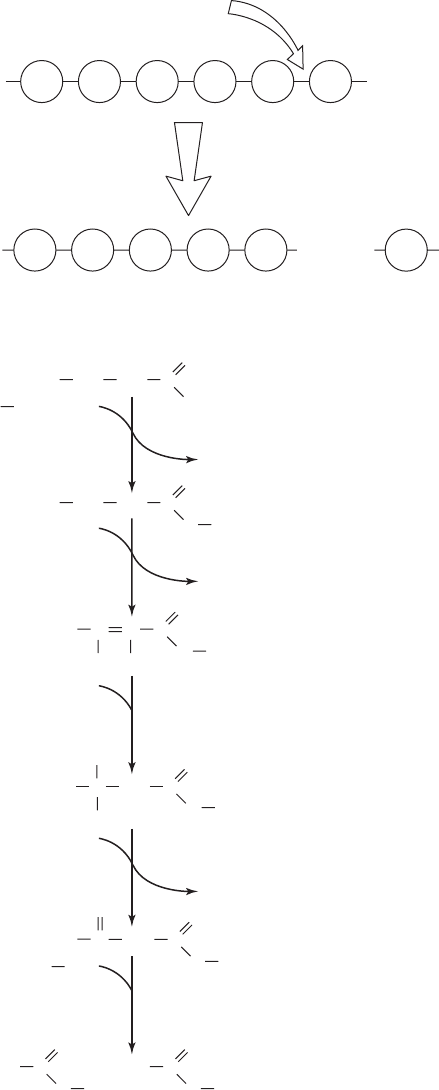
WASTEWATER MICROBIOLOGY 22-7
HO
H : O : H
H
HO
HO
H
H
+
FIGURE 22-2
H ydrolysis of a polymer.
CoA ⴙ ATP
H
2
O ⴙ AMP ⴙ PP
i
Activation
Dehydrogenation
(oxidation)
Hydration
H
2
O
R
CCH
2
C
FAD
FADH
2
O
R
CH
2
HS
CH
2
C
OH
O
R
CH
2
CH
2
CoA
C
S
S
CoA
S
O
R
CC
CoA
C
O
H
H
H
Dehydrogenation
(oxidation)
NAD
ⴙ
NADH ⴙ H
ⴙ
S
R
CCH
2
CoA
HS
CoA
C
O
O
S
R
C ⴙ CH
3
CoA
C
O
S
CoA
O
OH
Activation
FIGURE 22-3
-oxidation of fatty acids to acetyl-CoA.
( Source: Rittmann and McCarty, 2001.)
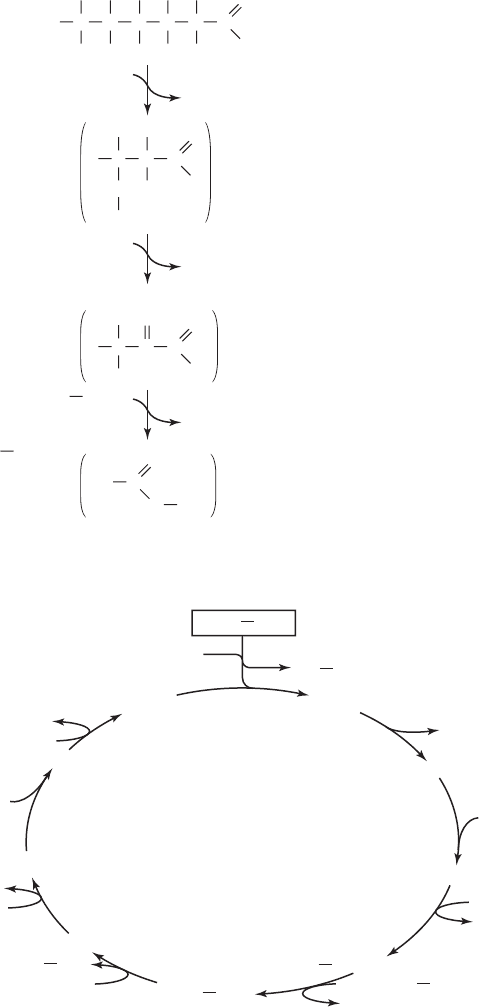
22-8 WATER AND WASTEWATER ENGINEERING
H
Glucose
Glyceraldehyde
3-phosphate
C
H
OH
C
H
OH
C
H
OH
C
OH
H
C
H
OH
C
H
O
H
2
C
O
OH
PO
3
2
C
OH
H
C
H
O
2ATP
2ADP
2NAD
2Pi
4ADP
2NADH
4ATP
2H
Pyruvic
acid
H
2
C
H
HO
CC
OH
O
CoA
CoA
CoA
2HS
2NAD
2NADH
2CO
2
2H
Acetyl
Activation
Oxidation and
substrate-level
phosphorylation
Oxidation and
activation
CH
3
2
C
S
O
FIGURE 22-4
Conversion of carbohydrates, represented here by glucose,
to acetyl CoA. ( Source: Rittmann and McCarty, 2001.)
CoA
GTP HS
GDP Pi
CoA
NADH + H
NAD
Citric
acid
cycle
Acetyl
FADH
2
FAD
CoA
NAD
NADH CO
2
NAD
HS
NADH CO
2
CoA
H
2
O
H
2
O
H
2
O
H
2
O
HS
Citrate
3
Aconitate
3
Isocitrate
3
Ketoglutarate
2
Succinate
2
Fumarate
2
Malate
2–
Oxalacetate
2
CoA
Succinyl
H
FIGURE 22-5
The citric acid cycle. ( Source: Rittmann and McCarty, 2001.)

WASTEWATER MICROBIOLOGY 22-9
The transport process proceeds through oxidative phosphorylation to convert the energy
stored in NADH and FADH
2
to ATP. The major pathway for mitochondrial electron transport is
shown schematically in Figure 22-6 . Glucose, for example, is degraded completely to CO
2
and
the electrons that are removed in the oxidative reactions are used to reduce the terminal electron
acceptor, oxygen, as shown in the following half-reaction:
1
4
1
2
22
OH e HO
(22-10)
End Products
A summary of substrate categories and representative end products is presented in Table 22-1 .
NADH Flavoprotein
Quinone Cytochrome B
Cytochrome C
Cytochrome aa
3
O
2
ADP ATP ADP ATP ADP ATP
FIGURE 22-6
The mitochondrial electron transport c hain for transfer of electrons from NADH to O
2
. NADH comes from
the citric acid cycle. From flavoprotein to quinone, four protons are translocated across an inner mitochondrial
membrane. This creates a proton gradient that is later used to generate ATP. From quinone to cytochrome B,
two electrons are removed.
TABLE 22-1
Substrates and representative end products
a
Under anoxic conditions the nitrates are converted to nitrogen gas.
A dapted from Pelczar and Reid, 1958.
Substrates
Aerobic and anoxic
decomposition
Anaerobic
decomposition
Proteins and other Amino acids Amino acids
nitrogen-containing Ammonia → nitrites Ammonia
compounds
→ nitrates
a
Hydrogen sulfide
Methane
Carbon dioxide
Alcohols
Organic acids
Carbohydrates Alcohols → CO
2
+ H
2
O Carbon dioxide
Fatty acidsFatty acids
Methane
Fats and related Fatty acids + glycerol Fatty acids + glycerol
substances Alcohols → CO
2
+ H
2
O Carbon dioxide
Lower fatty acids Alcohols
Lower fatty acids
Methane
22-10 WATER AND WASTEWATER ENGINEERING
Requirements for Microbial Growth
In order for bacteria to grow and maintain themselves, they must have available essential nutrients
such as carbon, nitrogen, phosphorus, sulfur, and the elements required for the synthesis of
proteins, nucleic acids, and other structural parts of the cells. If these requirements are not present in
available forms in the wastewater that i
s to be treated, they must be provided. This may be of
particular importance if a large fraction of the wastewater flow is contributed by industry.
The following list summarizes the major requirements that must be satisfied:
1 . A terminal electron acceptor
2. Macronutrients
a. Carbon to build cells
b.
Nitrogen to build cells (N:BOD
5
1:32)
c. Phosphorus for ATP (energy carrier) and DNA (P:BOD
5
1:150)
3. Micronutrients
a. Trace metals such as Co, Cu, Fe, Mn
b . Vitamins are required by some bacteria
4. Appropriate environment
a. Moisture
b . Temperature
c. pH
d. Light
22 -5 POPULATION DYNAMICS
In the discussion of the behavior of bacterial cultures which follows, there is the inherent
a ssumption that all the requirements for growth are initially present.
Pure Culture Growth Characteristics
A hypothetical laboratory experiment in which 1,400 bacteria of a single species are introduced
into a synthetic liquid medium provides an illustration of growth in pure cultures. Initially nothing
appears to happen. The bacteria must adjust to their new environment and begin to synthesize new
protoplasm. On a plot of bacterial growth versus time ( Figure 22-7 ), this phas
e of growth is called
the lag phase. In the start-up of new plants, the lag phase may show a decrease in population.
At the end of the lag phase the bacteria begin to divide. Because all of the organisms do not
divide at the same time, there is a gradual increase in population. This phase is labeled accelerated
growth on the growth plot.
At the end of the accelerated growth phase, the population of organisms is large enough and
the differences in generation time are small enough that the cells appear to divide at a regular rate.
Beca
use reproduction is by binary fission (each cell divides producing two new cells), the increase
in population follows in geometric progression: 1 → 2 → 4 → 8 → 16 → 32, and so forth. The
population of bacteria ( P ) after the n
th
generation is given by the following expression:
PP
n
0
2()
(22-11)
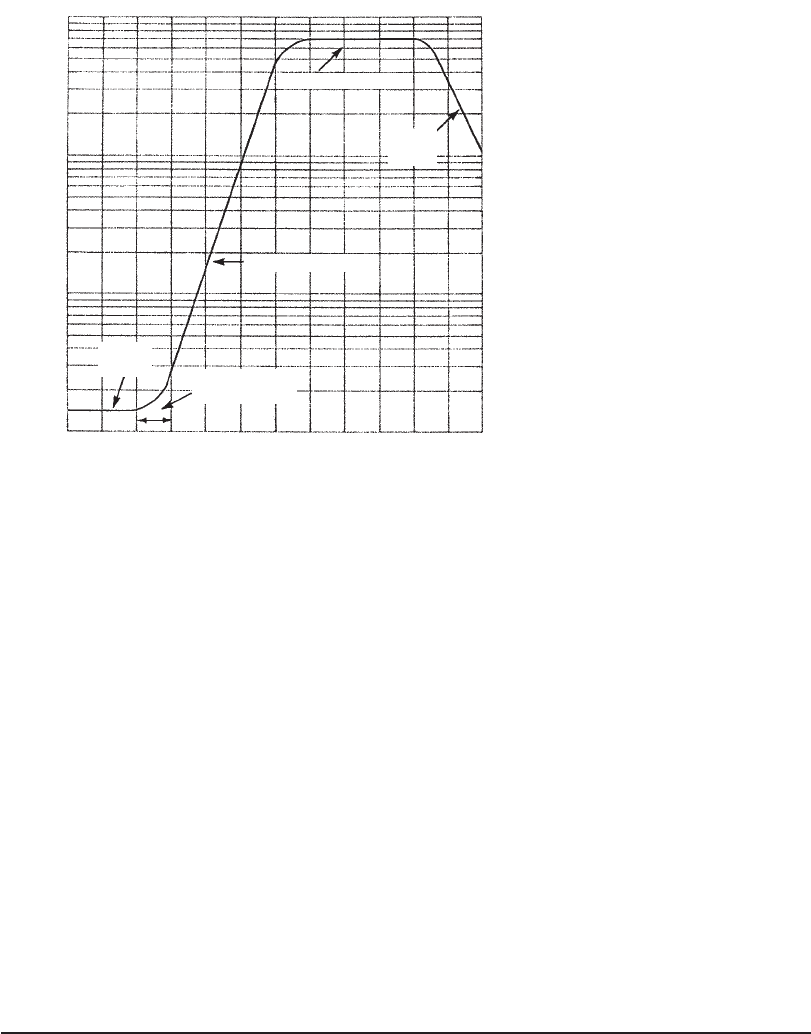
WASTEWATER MICROBIOLOGY 22-11
where P
0
i s the initial population at the end of the accelerated growth phase. Taking the log of
both sides of Equation 22-11 :
Log log logPPn
0
2
(22-12)
If the bacterial population is plotted on a logarithmic scale, this phase of growth plots as a straight
line of slope n and intercept P
0
at t
0
. This phase of growth is called the log growth or exponential
growth phase.
The log growth phase tapers off as the substrate becomes exhausted or as toxic byproducts
build up. Thus, at some point the population becomes constant either as a result of cessation of
fission or a balance in death and reproduction rate
s. This is depicted by the stationary phase on
the growth curve.
Following the stationary phase, the bacteria begin to die faster than they reproduce. This
death phase is due to a variety of causes that are basically an extension of those that lead to the
stationary phase.
Mixed Culture Growth Characteristics
In wastewater treatment, as in nature, pure cultures of microorganisms do not exist. Rather, a
mixture of species compete and survive within the limits set by the environment. Population
dynamics i s the term used to describe the time varying success of the various s pecies in
c
ompetition. It is expressed quantitatively in terms of relative mass of microorganisms. *
Death
phase
Stationary phase
Time, h
5 10 15 20 25 30 35 40 45 50 55 60
Accelerated
growth phase
Bacterial numbers
Lag
phase
Log growth phase
10
3
10
4
10
6
10
5
FIGURE 22-7
P ure culture bacterial growth curve.
( Source: Davis and Cornwell, 2008.)
*If each individual organism of species A has, on the average, twice the mass at maturity as each individual organism of species
B, and both compete equally, one would expect that both would have the same total bioma
ss, but that there would be twice as
many of species B as there would be of A.
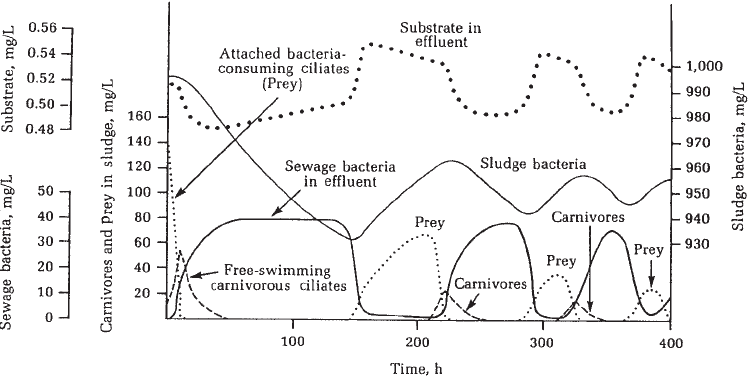
22-12 WATER AND WASTEWATER ENGINEERING
The prime factor governing the dynamics of the various microbial populations in sewage is
the competition for substrate (organic matter in the wastewater that is colloquially called food ).
The second most important factor is the predator-prey relationship.
The relative success of a pair of species competing for the same substrate is
a function of the
ability of the species to metabolize the substrate. The more successful species will be the one that
metabolizes the substrate more completely. In so doing, it will obtain more energy for synthesis
and consequently will achieve a greater mass.
Because of their relatively smaller size and, thus, larger surfa
ce area per unit mass, which
allows a more rapid uptake of substrate, bacteria will predominate over fungi. For the same
reason, the fungi predominate over the protozoa.
When the supply of soluble organic substrate becomes exhausted, the bacterial population is
less successful in reproduction and the predator populations in
crease. In a closed system with an
initial inoculum of mixed microorganisms and substrate, the populations will cycle as the bacteria
give way to higher level organisms that in turn die for lack of substrate and are then decomposed
by a different set of bacteria ( Figure 22-8 ). In an open system
, such as a wastewater treatment
plant or a river, with a continuous inflow of new substrate, the predominant populations will
change through the length of the plant ( Figure 22-9 ). This condition is known as dynamic equi-
librium. It is a highly sensitive s tate, and changes in influent characteristics must be regulated
closely to maintain the proper balan
ce of the various populations.
For the large numbers and mixed cultu res of microorganisms found in waste treatment
systems, it is convenient to measure biomass rather than numbers of organisms. Frequently, this
is done by measuring the suspended
solids or volatile suspended solids (VSS), that is, those that
burn at 550C 50 C. When the wastewater contains only soluble organic matter, the volatile
suspended s olids test is reasonably representative. The pres ence of organic particles (which is
often the case in municipal wastewater) confuses the issue c
ompletely.
FIGURE 22-8
Population dynamics in a closed system. ( Source: Curds, 1973.)
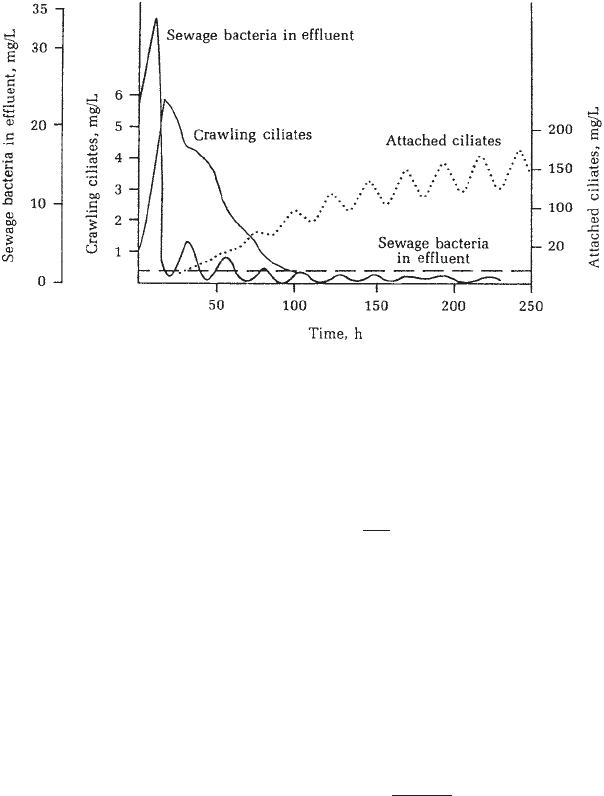
WASTEWATER MICROBIOLOGY 22-13
The Monod Equation
In the log-growth phase, the rate expression for biomass increase is
dX
dt
X
(22-13)
where dX / dt growth rate of the biomass, mg/L d
specific growth rate constant due to synthesis, d
1
X concentration of biomass, mg/L
Because of the difficulty of direct measurement of in mixed cultures, Monod (1949) devel-
oped a model equation that assumes that the rate of substrate utilization, and therefore the rate of
biomass production, is limited by the rate of enzyme reaction
s involving the substrate compound
that is in shortest supply relative to its need. The Monod equation is
m
s
S
KS
(22-14)
where
m
maximum specific growth rate, d
1
S concentration of rate limiting substrate, mg/L
K
s
half saturation constant, mg/L
concentration of limiting substrate when = 0.5
m
The growth rate of biomass follows a hyperbolic function as shown in Figure 22-10 .
Two limiting cases are of interest in the application of Equation 22-14 to wastewater treat-
ment systems. In those cases where there is an excess of the limiting substrate, then S K
s
and the growth rate constant i s approximately equal to
m
. Equation 22-14 then becomes zero-
order in substrate. At the other extreme, when S K
s
, the system is substrate-limited and the
growth rate becomes first-order with respect to substrate.
FIGURE 22-9
Population dynamics in an open system. ( Source: Curds, 1973.)

22-14 WATER AND WASTEWATER ENGINEERING
Equation 22-14 assumes only growth of microorganisms and does not take into account natu-
ral die-off. It is generally assumed that the death or decay of the microbial mass is a first-order
expression in biomass and hence Equations 22-13 and 22-14 are expanded to
dX
dt
SX
KS
kX
m
s
d
(22-15)
or
r
SX
KS
kX
g
m
s
d
(22-16)
where k
d
endogenous decay rate constant, d
1
.
r
g
net biomass production rate, g VSS/m
3
d
If all of the substrate in the system were converted to biomass, the rate of substrate utilization
( dS / dt ) would equal the rate of biomass production. Because of the inefficiency of the conversion
process, the rate of substrate utilization will be greater than the rate of biomass utilization, so
dS
dt Y
dX
dt
1
(22-17)
where Y decimal fraction of substrate mass converted to biomass
yieldcoefficient
mg/L biomass
mg/L substra
,
tteutilized
Combining Equations 22-13 , 22-14 , and 22-17 :
dS
dt Y
SX
KS
m
s
1
(22-18)
or
r
Y
SX
KS
su
m
s
1
(22-19)
where r
su
substrate utilization rate or rate of substrate concentration change due to utilization.
K
s
Limiting food concentration S, mg/L
m
2
m
Growth rate constant, , d
1
FIGURE 22-10
Monod growth rate constant as a function of limiting food con-
centration. ( Source: Davis and Cornwell, 2001.)
WASTEWATER MICROBIOLOGY 22-15
E q uations 22-16 and 22-19 are a fundam ental part of the development of the design equa-
tions for wastewater treatment processes.
22 -6 DECOMPOSITION OF WASTE
The type of electron acceptor available for catabolism determines the type of dec omposition
(i.e., aerobic, anoxic, or anaerobic) used by a mix ed culture of microorganisms. Each type
of decom position has particular characteristics that affect its use in wastewater treatment.
In the following paragraphs
a general discussion of the three types of decomposition is
presented.
Aerobic Decomposition
Molecular oxygen (O
2
) must be present as the terminal electron acceptor for decomposition to
proceed by aerobic oxidation. The oxygen is measured as dissolved oxygen (DO). When oxygen
is present, it is the only terminal electron acceptor used. The chemical end products of decompo-
sition are pri
marily carbon dioxide, water, and new cell material. Odiferous gaseous end products
are kept to a minimum. In healthy natural water systems, aerobic decomposition is the principal
means of self purification.
A wider spectrum of organic material can be oxidized aerobically
than by any other type of
decomposition. This fact, coupled with the fact that the final end products are oxidized to a very
low energy level, results in a more stable end product (i.e., one that can be disposed of without
damage to the environment and without creating a nuisance condition) than can be achieved by
the other oxidation systems.
Because of the large amount of energy released in aerobic oxidation, most aerobic organisms
are capable of high growth rates. Consequently, there is a relatively large production of new cells
in comparison with the other oxidation systems. This means that more biological sludge is
gener-
ated in aerobic oxidation than in the other oxidation systems.
Aerobic decomposition is the method of choice for large quantities of dilute wastewater
(BOD
5
less than 500 mg/L) because decomposition is rapid, efficient, and has a low odor
potential. Typically, aerobic decomposition is not suitable for high strength wastewater (BOD
5
is greater than 1,000 mg/L) because of the difficulty in supplying enough oxygen and because of
the large amount of biological sludge produced. However, in small communities and in special
industrial applications where aerated lagoons are used, wastewater with BOD
5
up to 3,000 mg/L
may be treated satisfactorily by aerobic decomposition. This is because the daily influent
volume of wastewater is small, the detention time is long, and the lagoon acts as a complete mix
reactor.
Anoxic Decomposition
Some microorganisms can use nitrate (NO
)
3
as the terminal electron acceptor in the absence of
molecular oxygen. Oxidation by this route is called denitrification.
The end products from denitrification are nitrogen gas, carbon dioxid e, water, and new c ell
material. The amount of energy made available to the cell during denitrification is about the
same
as that made available during aerobic decomposition. As a consequence, the rate of production of
new cells, although not as high as in aerobic decomposition, is relatively high.
Denitrification is of importance in wastewater treatment where nitrogen must be removed
to protect the receiving body. Another important aspect of denitrification is
in relation to final
22-16 WATER AND WASTEWATER ENGINEERING
clarification of the treated wastewater. If the environment of the final clarifier becomes anoxic,
the formation of nitrogen gas will cause large globs of sludge to float to the surface and escape
from the treatment plant into the rec eiving water. Thus, it is necessary to ensure that anoxic
conditions do not develop in the final clarifier.
Anaerobic Decomposition
In order to achieve anaerobic decomposition, molecular oxygen and nitrate must not be present
as terminal electron acceptors. Sulfate
(SO
)
4
2
, carbon dioxide, and organic compounds that can
be reduced serve as terminal electron acceptors. The reduction of sulfate results in the production
of hydrogen sulfide (H
2
S) and a group of equally odoriferous organic sulfur compounds called
mercaptans.
The anaerobic decomposition ( fermentation ) of organic matter generally is considered to
be a three-step process. In the first step, waste components are hydrolysed. In the second step,
c
omplex organic compounds are fermented to low molecular weight fatty acids ( volatile acids ).
In the third step, the organic acids are converted to methane. Carbon dioxide serves as the electron
acceptor.
Anaerobic decomposition yields carbon dioxide, methane, and
water as the major end
products. Additional end products include ammonia, hydrogen sulfide, and mercaptans. As a
consequence of these last three compounds, anaerobic decomposition is characterized by highly
objectionable odors.
Becaus
e only small amounts of energy are released during anaerobic oxidation, the amount
of cell production is low. Thus, sludge production is low. This fac t is used in wastewater treat-
ment to stabilize and reduce the volume of sludges produced during aerobic and anoxic
decom-
position.
T ypically, direct anaerobic decomposition of wastewater is not used for dilute municipal
wastewater. The optimum growth temperature for the anaerobic bacteria is at the upper end of the
mesophilic range. Thus, to get reasonable biodegradation, the temperature of the culture must be
elevated. For d
ilute wastewater, this is not practical. For concentrated wastes (BOD
5
greater than
1,000 mg/L) and sludge treatment, anaerobic digestion is quite appropriate.
22 -7 MICROBIOLOGY OF SECONDARY TREATMENT
UNIT PROCESSES
Four commonly used secondary treatment unit proc esses are aerobic ox idation, nitrification,
denitrification, and phosphorous removal. An additional unit process that is becoming more
common is the activated sludge selector. The objectives of these processes m
ay be summarized as:
• Aerobic oxidation: removal of readily biodegradable COD (rbCOD) or BOD.
• Nitrification: oxidation of ammonia (NH
4
-N) to nitrate.
• Denitrification: reduction of nitrate to nitric oxide, nitrous oxide, and nitrogen gas.
• Phosphorous removal: incorporation of phosphorus into cell biomass that is subsequently
removed from the process.
• Selector: adjustment of the ecology of the activated sludge system to favor those organisms
with good settling characteristics.
